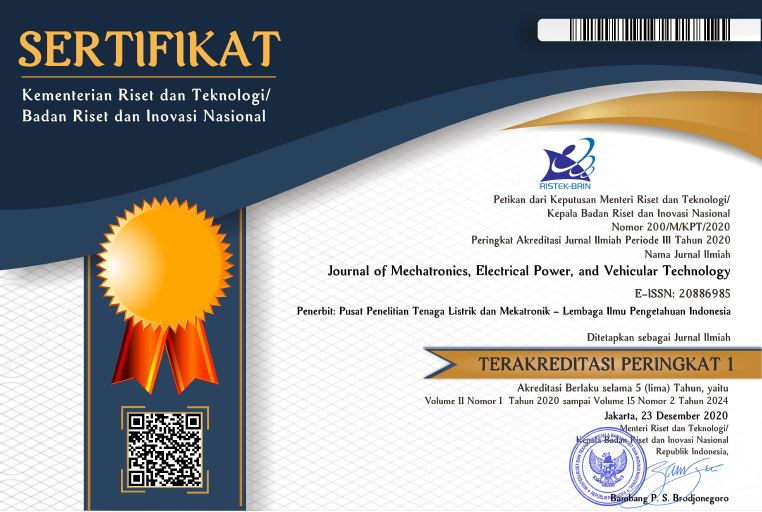Numerical investigation of the effect of triangle strut in vertical axis wind turbine (VAWT)
Abstract
Strut is used in vertical axis wind turbine (VAWT) to restraint the framework. In this study, struts are analyzed to show the pressure losses in VAWT. ANSYS computational fluid dynamics (CFD) software is used to investigate triangle strut in VAWT. This study aims to show a CFD simulation of struts, which affects the aerodynamic of VAWT. In CFD software, the aerodynamic of VAWT can be analyzed in terms of pressure losses in the struts. The simulation method starts by making a struts model, then meshing and setting up ANSYS's boundary conditions. The last iteration runs in ANSYS until convergence. Our results show the percentage of pressure losses with the variation of the angle of wind 0°, 20°, 40°, and 60° are 0.67 %, 0.52 %, 0.48 %, and 0.52 %. The effect of triangle strut in VAWT did not affect the wind flow to the VAWT blade. The results also indicated that the triangle strut could be applied in the multi-stage of VAWT system.
Keywords
Full Text:
PDFReferences
S. Siddiqui, N. Durrani, and I. Akhtar, “Numerical study to quantify the effects of struts & central hub on the performance of a three-dimensional vertical axis wind turbine using sliding
mesh,” in Proceedings of the ASME 2013 Power Conference, 2013, pp. 1–11.
Y. Bazilevs, A. Korobenko, X. Deng, J. Yan, M. Kinzel, and J. O. Dabiri, “Fluid – structure interaction modeling of vertical-axis wind turbines,” J. Appl. Mech., vol. 81, no. August, pp. 1–8, 2014.
T. C. Hohman, L. Martinelli, and A. J. Smits, “The effects of inflow conditions on vertical axis wind turbine wake structure and performance,” J. Wind Eng. Ind. Aerodyn., vol. 183, no. October, pp. 1–18, 2018.
A. Goude, S. Lundin, and M. Leijon, “A parameter study of the influence of struts on the performance of a vertical-axis marine current turbine,” in Proceedings of the 8th European Wave and Tidal Energy Conference, 2009, pp. 477–483.
P. Bachant and M. Wosnik, “Performance and near-wake measurements for a vertical axis turbine at moderate Reynolds number,” in Proceedings of the ASME 2013 Fluids Engineering Division Summer Meeting, 2013, pp. 1–9.
A. R. Davari, “Wake structure and similar behavior of wake profiles downstream of a plunging airfoil,” Chinese J. Aeronaut., no. June, pp. 1–13, 2017.
S. Hanchi, T. Benkherouf, M. Mekadem, and H. Oualli, “Wake structure and aerodynamic characteristics of an auto-propelled pitching airfoil,” J. Fluids Struct., vol. 39, pp. 275–291, 2013.
H. Lee and D. Lee, “Numerical investigation of the aerodynamics and wake structures of horizontal axis wind turbines by using nonlinear vortex lattice method,” Renew. Energy, 2018.
A. Posa, C. M. Parker, M. C. Leftwich, and E. Balaras, “Wake structure of a single vertical axis wind turbine,” Int. J. Heat Fluid Flow, vol. 0, pp. 1–10, 2016.
Y. Ahmudiarto, A. M. Romadoni, T. B. Karyanto, T. Admono, B. Nugroho, R. C. Chin, and A. Budiyono, “Performance Analysis of Novel Blade Design of Vertical Axis Wind Turbine,” in 2019 International Conference on Sustainable Energy Engineering and Application (ICSEEA), 2019, pp. 175–181.
T. Wah-yen, Y. Asako, N. Azwadi, C. Sidik, and G. Rui-zher, “Governing equations in computational fluid dynamics: derivations and a recent review,” Prog. Energy Environ., no. June, pp. 1–19, 2017.
Y. Wei, “The development and application of CFD technology in mechanical engineering The development and application of CFD technology in mechanical engineering,” in IOP Conf. Series: Materials Science and Engineering, 2017, pp. 1–9.
W. Liu and Q. Xiao, “Investigation on Darrieus type straight blade vertical axis wind turbine with flexible blade,” Ocean Eng., vol. 110, pp. 339–356, 2015.
S. Ogawa and Y. Kimura, “Performance improvement by control of wingtip vortices for vertical axis type wind turbine,” Open J. Fluid Dyn., vol. 8, pp. 331–342, 2018.
A. Rezaeiha, H. Montazeri, and B. Blocken, “Towards accurate CFD simulations of vertical axis wind turbines at di fferent tip speed ratios and solidities: Guidelines for azimuthal increment, domain size and convergence,” Energy Convers. Manag., vol. 156, no. October 2017, pp. 301–316, 2018.
Article Metrics
Metrics powered by PLOS ALM
Refbacks
- There are currently no refbacks.
Copyright (c) 2020 Journal of Mechatronics, Electrical Power, and Vehicular Technology

This work is licensed under a Creative Commons Attribution-NonCommercial-ShareAlike 4.0 International License.
Cited-By
1. Vertical axis wind turbine operation in icing conditions: A review study
Syed Abdur Rahman Tahir, Muhammad Shakeel Virk
Wind Engineering vol: 46 issue: 4 first page: 1331 year: 2022
doi: 10.1177/0309524X211061828




















